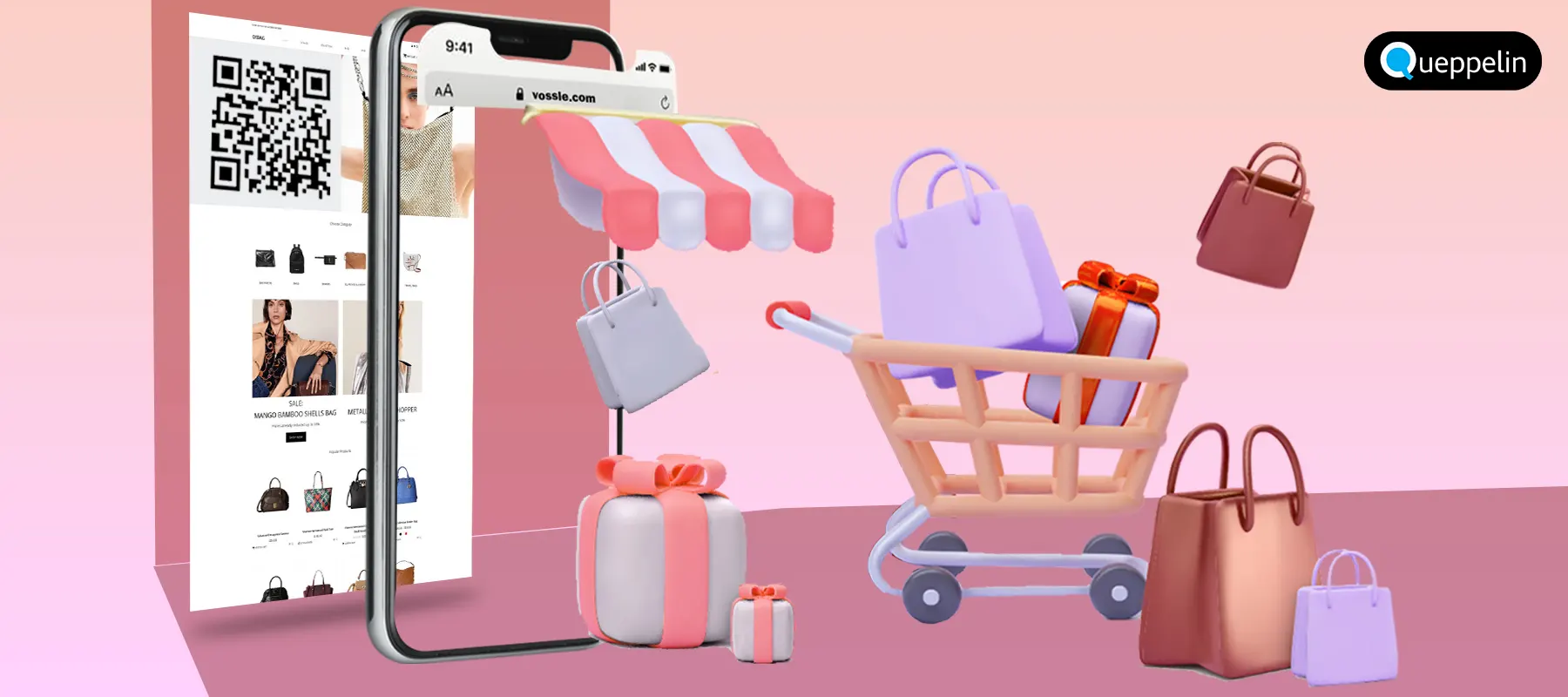Try-Ons are the evolutionary form of shopping experiences that merge the physical and digital worlds. It adds convenience and clarity to shopping, resulting in better decision-making on the customer’s part and more sales on the brand’s part.
Here, we discuss all possible forms of virtual try-on emerging with the evolution of AR technology, along with the various unprecedented benefits it offers to the customer and the brand alike.
What is a Virtual Try-On?
In simple words, virtual try-on, also known as “virtual fitting” or “digital try-on,” is a technology that lets users explore or “try on” products digitally, like a pair of pants or test the way a certain shade of lipstick looks, using a computer or mobile device.
With try-on, users can examine the product, check out its dimensions and size, understand its operations and functions, and much more. The technology uses Augmented Reality which layers digital objects over the real world using the device’s camera.
Interestingly, AR-driven virtual try-on experiences are not just limited to wearables but also product categories such as home decor, home appliances, furniture, and many others. In fact, many big brands, such as IKEA, are already using the technology to provide product visualization and demonstration at any place of the users’ choice.
Customers get a much better understanding of the product than just scrolling through 2D images on the product page of their online store. The immersive experience so provided is comparable to examining a real-life product, which helps make faster and more informed decisions. This helps brands boost sales while reducing returns, resulting in expanded profit margins while building a strong brand image and a loyal audience base.
You can have your virtual try-on built by specialists at Queppelin
How does Virtual Try-on work?
There are three ways to access virtual try-on as of now, and these are:
The first and most widely adopted way is that users can use the camera on their smart devices, like mobile phones, tablets, laptops, etc., to access try-on functionality.
In this, the inherent AR technology combines the device’s motion tracking, camera scene capture, advanced scene processing, and display conveniences to superimpose 3D models on the user’s body.
Such models are very responsive to users’ body movements and behave just like their real-world counterparts. This method is used by online stores to provide users with a virtual try-on experience in their homes or anywhere they want.
Another way of experiencing virtual try-on is through AR mirrors in physical stores. These smart mirrors capture customers’ appearance and overlay it with digital wearable products like clothing, make-up, pieces of jewelry, home decor, home appliances, furniture, etc.
Given the possibility of installing better hardware and having more computational power, in-store try-on experiences can function better than digital try-ons.
The third way is by creating 3D digital avatars through body scanning technology. One popular example is Apple’s iPhone. The iPhone series 12 and above have inbuilt LiDAR functionality that measures the dimensions of real-life objects. Users can use it to create accurate 3D avatars and try on products. The end result gives the exact look of the product as that of the user wearing it in the real world.
These were the three ways of executing a virtual try-on experience that we know of, at least for now. You can take any of these routes. However, now the question arises: what types of products can you try digitally? This takes us to our next segment, where we have divided the types of virtual try-ons on the basis of the underlying products. So, let’s take it up one by one.
7 Types of Virtual Try-Ons
Creating a virtual try-on involves is a complex process and involves multiple steps such as programming for relevant body part tracking, 3D modeling and 3D animation of the required 3D elements involved in the experience, interactivity integration, cross-platform optimization, etc.
Plus, each of these processes may involve a different way of execution. For example, body part tracking can be done through AI-driven image-based tracking, code-based manual tracking, or tracking with the help of 3D mesh layering.
Anyway, this is a discussion for some other day. Right now, for an easy understanding of the topic at hand, we can segregate virtual try-on into seven types and comprehend their wide-ranging potential. These are
- Glass Try-on,
- Jewelry Try-on,
- Accessories Try-on,
- Clothing Try-on,
- Furniture Try-on,
- Make-up Try-on,
- Home Decor Try-on, etc.
So, let’s start with the Glasses Tryon experience.
Glasses Try-On
This is arguably the most popular type of virtual try-on out there. It overlays eyewear products like glasses and sunglasses on users’ faces.
This technology requires head and face tracking and acquiring data like the distance between the eyes, the position of the ears, the height of the forehead, the width of the face, etc. to place digital 3D models of the eyewear accordingly on the users’ faces.
Using this type of try-on, users can see how a particular frame would look on them, the color of the glass, and much more.
This gives them a much better idea of the product while shopping online compared to just looking at a model wearing the glasses in a static, non-interactive image.
Jewelry Try-On
This type of try-on helps customers try jewelry digitally and check how the design, shape, and size look on the user. This try-on is suitable for all kinds of jewelry including nose rings, earrings, jewelry headpieces, bracelets, rings, etc.
To enable this Jewelry try-on, incorporate different approaches depending upon the type of jewelry. For example, try-ons of headpieces, a nose ring, and earrings require face and head tracking, while the ring and bracelet try-ons require hand tracking.
Further, there is an additional benefit to this try-on. Jewelry brands can offer AR-enabled product visualization on their online stores so customers can try their jewelry digitally. Thus enabling the store to keep low inventory, reducing the threat of loss and damage to valuable products.
Clothing Try-On
Clothing try-on is a method of trying out 3D digital apparel. The technique involves scanning the body, whether upper, lower, or both, and conjuring up real-time interactive 3D models of clothing.
Such types of try-ons are a little difficult to execute given the differences in individual bodies. However, the technology is rapidly evolving, and gradually more realistic and accurate clothing try-ons are hitting the market. For this, they utilize AI and ML for a realistic overlay of the digital clothing product with accurate responses to customers’ movements.
Watch Try-On
Watch Tryon is yet another intriguing try-on category. Users can wear 3D models of watches that clearly show the shape and face of the dial, get an idea of the texture and material of the band, explore functionalities, etc.
These insightful experiences help users make faster and better decisions. They can see how the actual watch will look on them, and if it goes along with their style, they can just purchase the actual watch then and there.
Shoe Try On
Shoe try-on scans the users’ feet and superimposes virtual shoes on the same. These experiences help users understand the look and feel of the product better. The experiences clearly showcase the multiple colors, designs and patterns, sole thickness, and much more through a stable and smooth AR footwear experience.
Make-up Try On
Makeup Try-on experiences are as popular as Glasses Try-on experiences. They help customers choose the right product based on their skin tone and facial features. Not only can they decide the color, but even the shade of the product and whether to go for a glossy finish or a matte finish. These experiences can include lipstick tryon, eye shadow tryon, eye lenses tryon, eyeliner tryon, or the tryon for hair color, hair extensions, etc.
Many companies operating in the space have also incorporated AR-based tutorials to help their customers use the product in the correct manner. This improves brand engagement and builds a strong connection with the customer while expanding the audience base.
Furniture & Home Decor Try On
Furniture try-on offers product visualization capabilities for furniture and home decoration. Users can check the dimensions, construction, color, design, and patterns of the furniture. They can use AR to digitally place the object in their living room and see if it goes with the interior and whether they have enough space to place it there.
Similarly, users can place home accessories products such as window dressings, plants, or artworks at the place of their choice and check how they will look once placed in reality.
These try-ons bring immense benefits to users and brands alike. On one hand, they help customers make faster and better purchase decisions by bringing realistic product visualization into their homes.
On the other hand, brands can achieve recognition for their value-added efforts to the user’s experience and gain a competitive advantage.
In the next segment, we will discuss the advantages of Virtual Try-on in detail.
Why does your business need Virtual Try Ons?
Virtual try-on is an excellent technology for improving the interaction between buyers and businesses. Notably, all these benefits are interconnected with each other and contribute to the overall digital ecosystem. Here, we discuss the advantages of virtual try-on for customers and businesses separately.
Benefits of Virtual Try-On for customers
Virtual Try-ons enable Ease, Interaction to the Shopping Experience
Shopping with virtual try-ons adds a significant degree of convenience to the online shopping experience for users. Web 2.0 was predominantly dominated by a two-dimensional (2D) shopping experience, which lacked interaction.
However, Web 3.0 employs state-of-the-art technologies to provide customers with an immersive experience where they can try or interact with the product while shopping in a store.
The most important part is that they do not need to leave the comfort of their home or fight through the traffic to reach a physical store only to find that the product they are looking for is out of stock or that their size is unavailable.
Virtual Try-ons help you make Confident & Transparent Shopping Decisions
I ordered something online after viewing the 2D product images, but the actual product that arrived was completely different. Haven’t we all faced this situation while shopping online?
360-degree 3D product visualization coupled with AR-enabled try-ons can help solve this problem. Users can interact with the product as if they were interacting with a real product making confident purchase decisions.
Virtual Try-ons offer a transparent idea of the product, its dimensions, and its features, helping users make an informed purchase. This also reduces the chances of returning the product, as they get what they wanted.
Try-ons add a personalized approach
AI (real-time image processing, computer vision, deep learning, and other AI technologies) enables Try-ons to provide immersive experiences, immersion adds value to customers’ shopping experience and this end-to-end experience creates a personalized experience for the customer.
Personalization is no longer a nice-to-have, it’s a must. The modern consumer doesn’t like being treated as a number. They want to feel as though their purchase is special and important to the business.
Try-on experiences add convenience and deepen users’ brand interaction to develop a deeper connection with the business. Customers gradually begin to share their brand experiences in their social circles.
After all, customer experience is a deciding factor for 73% of consumers when making a purchase, and 61% of them will pay at least 5% more if they are convinced of a good customer experience.
Benefits of Virtual Try-On for Businesses
Reduces the number of products that are returned back
As per the National Retail Federation, the world’s largest retail trade association, US consumers have returned an estimated $816 Billion worth of merchandise to retailers in 2022. This is approximately 16.5 percent of the total $4.95 Trillion U.S. retail sales in the same year.
Out of this, online sales totaled around $1.29 Trillion with returns worth $212 Billion, or around 16.5 percent.
As per the statistics, about 80% of these returns weren’t due to defective products.
This is where try-ons can show their true potential. Brands can employ virtual try-ons for both online and offline shopping to allow users to interact with the product as they would with the real one.
Through personalized digital trials, virtual try-ons render a realistic idea of the product to the customer and help them find precisely what they are looking for. They can understand its dimensions and functions, decide whether they want it or not, and make a confident purchase that does not lead to a return.
As noteworthy as it is, it also saves the product from physical damage or theft, especially the products like jewelry that come at a premium price.
Gain a Competitive Edge
From $3.5 billion in 2017, the AR industry will reach $198 billion by 2025. This shows the wide deployment of the technology in the coming times, making it omnipresent.
However, in 2023, we are at a time when AR technology has started to expand its horizons. So, the brands that make the first move with AR will get a better return than those who lose time while contemplating.
Early adopters of AR will establish themselves as market leaders, driving more audience engagement through added popularity and curiosity around the brand than ever before.
They will gain considerable competition by gaining customer loyalty on account of their innovative engagement with customers who advocate on their behalf.
Boost Sales
Virtual Try-ons have a direct impact on sales and profitability by increasing customer conversion rates and spending.
First, the innovative experience helps brands create a positive and trustworthy image in customers’ minds. They develop an appreciation for the brand for providing a unique experience and going the distance to help them in decision-making.
Second, customers are interested in customized items and are willing to pay a premium, thereby enhancing the brand’s profitability.
On top of it, with the increase in AR accessibility through mobile phones, more and more users are experiencing this new form of engagement and witnessing instant, realistic, and personalized product representation. Thus, more and more people are entering the brand’s sales funnels, leading to more sales.
Conclusion
Virtual Try-on brings benefits to both users and businesses. It offers convenience to buyers in terms of saving time and money and offering transparency while making an online purchase. At the same time, it reduces the number of products returned due to numerous reasons, saving businesses a lot of money. It also helps businesses develop a deeper and long-term relationship with their customers that ensures success and profitability.
Thus, virtual try-on is no longer a new option but a must-have asset for businesses.
However, a word of caution: a poorly developed try-on experience could even discourage a consumer and stop them from making the purchase. Thus, an expert in developing virtual try-ons like Queppelin can help you navigate this territory successfully and with ease.






